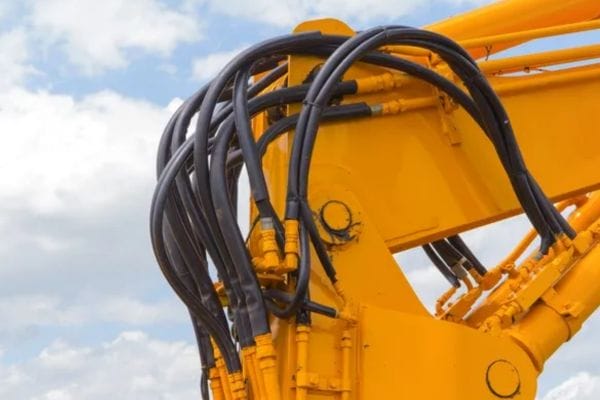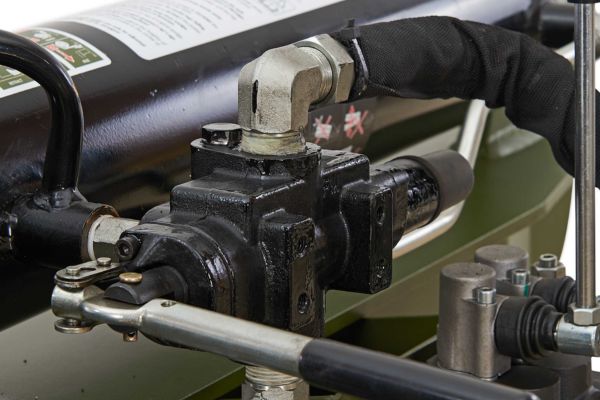Not all hydraulic hoses are built to last. Substandard hoses may look similar at first glance, but they often hide serious quality flaws that can lead to leaks, burst failures, and safety risks.
The First Impression: Judging by the Cover
Your first interaction with a hose can reveal a lot about its quality.
A well-manufactured hose always shows it — in the consistency of its surface, the precision of its markings, and the integrity of its cover rubber.
| Observation | What It Tells You | Quality Indicator |
| Smooth, even cover texture | Proper compounding and curing | ✅ High-quality |
| Visible bubbles or bumps | Poor rubber mixing or trapped gas | ⚠️ Low-quality |
| Pinholes or pockmarks | Inconsistent curing temperature | ⚠️ Defective batch |
| Firm, dense feel (not spongy) | Correct pressure during extrusion | ✅ Reliable cover |
Tip: A quick tactile check — pressing the hose cover with your thumb — should feel firm and elastic, not soft or uneven.
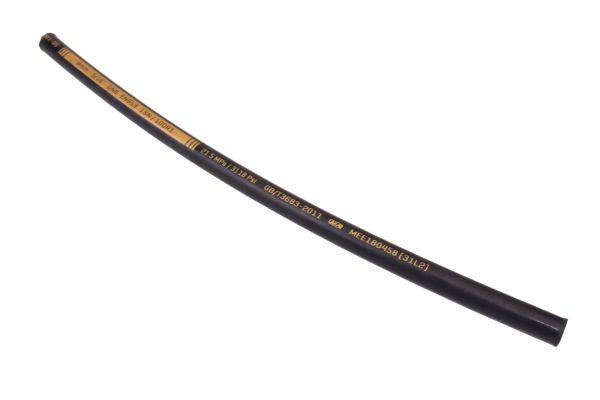
Analyzing the Surface Finish
The outer cover is the hose’s first layer of defense against abrasion, ozone, and oil.
A premium cover will appear:
- Smooth and uniform, with no visible imperfections
- Matte or semi-glossy, depending on material type (NR, NBR, CR)
- Evenly thick along the entire length
Defects like sponginess, bubbles, or sand eyes indicate poor control during compounding or curing. These weaknesses allow moisture and oil to penetrate, ultimately attacking the reinforcement layers beneath.
Reading the Layline for Clues
The layline — the printed identification running along the hose — isn’t just branding. It’s a sign of quality control.
A professional-grade hose will have:
- Crisp, clear, and durable printing that resists smearing
- Consistent spacing and alignment along the entire length
- Complete information, including manufacturer name, pressure rating, and standard (e.g., SAE 100R2AT, EN 853 2SN)
| Layline Feature | What It Indicates |
| Crisp and permanent printing | Good surface curing and QA tracking |
| Blurry or easily rubbed-off text | Poor finishing or low-quality ink |
| Missing standard codes | Non-compliant or counterfeit hose |
When printing looks cheap, the manufacturing process probably was too.
The Skiving Test for Cover Quality
In applications where the hose needs skiving — the removal of the outer rubber layer before crimping — cover quality becomes even more obvious.
What to check:
- The rubber should peel off in a smooth, continuous strip using a skiving tool.
- A cover that crumbles, tears, or produces powdery residue indicates poor-quality compounds or over-cured rubber.
- The exposed reinforcement layer should remain intact and undamaged.
Pro Insight:
A well-compounded rubber layer behaves like dense leather — it cuts cleanly and evenly. Inferior hoses often feel brittle or flaky under the tool.
A Look Inside: Analyzing the Hose Cross-Section
Cutting a sample piece of hose reveals the true story of its construction. The internal geometry and the quality of the rubber compounds are critical factors that cannot be judged from the outside alone. A clean cut is a window into the hose’s soul.
Concentricity is Non-Negotiable
Look at the cut end of the hose. The inner tube, reinforcement layers, and outer cover should be perfectly concentric—like rings in a tree trunk. An off-center bore means the wall thickness is uneven, creating a critical weak point that will likely be the first place to fail under pressure.
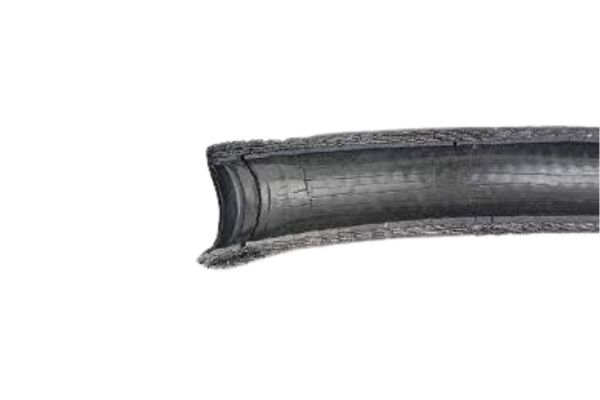
The Fingernail Test: Gauging Rubber Elasticity
Gently press your fingernail into the cut surfaces of the inner tube and outer cover. The rubber on a high-quality hose will feel firm but elastic, indenting slightly and then returning to its original shape. Poor quality rubber will either feel excessively hard and brittle or too soft and spongy.
Assessing the Inner Tube Finish
The inner tube, or bore, should have a smooth, glossy finish. A dull or rough-looking interior can indicate the use of low-grade materials or improper manufacturing. This can increase fluid friction and may suggest a higher potential for the tube material to break down and contaminate the system.
The Heart of the Hose: Inspecting the Reinforcement
The steel wire reinforcement is what gives a hydraulic hose its pressure-containing capability. The quality, uniformity, and construction of this layer are arguably the most critical factors in determining a hose’s strength, durability, and overall performance.
Uniformity of the Braid or Spiral
Whether it’s a braided or spiral-wound hose, the wire reinforcement must be perfectly uniform. Look for even spacing between the wires with no gaps or bunched-up sections. Any inconsistency in the weave creates a stress concentration point, making the hose vulnerable to premature failure.

Wire Diameter and Tensile Strength
While difficult to measure without specialized tools, a general visual inspection can be revealing. The wire in high-quality hose will appear robust and substantial. Thicker, high-tensile steel wire provides superior burst and impulse resistance compared to the thinner, lower-grade wire used in budget hoses.
The Importance of Full Coverage
The reinforcement layers must provide complete and total coverage around the inner tube. Any area where the braid is thin or wire is missing (“leakers” in the braid) is a built-in defect. Under pressure, the inner tube will try to extrude through this gap, causing a sudden and catastrophic burst.
| Reinforcement Type | Construction | Key Characteristics | Typical Applications |
| Wire Braid | Wires are crisscrossed in a braided pattern over the inner tube (e.g., SAE 100R1, 100R2, 100R16). | Highly flexible, excellent for routing in tight spaces, good for medium to high pressures. | Mobile equipment (excavators, loaders), general industrial machinery, power steering lines, return lines. |
| Wire Spiral | Wires are laid in parallel and wound in helical layers around the inner tube (e.g., SAE 100R12, 100R13, 100R15). | Less flexible than braid, superior impulse life and resistance to shock pressures, used for very high and ultra-high pressures. | Hydrostatic drives, excavators, mining equipment, off-shore drilling, applications with extreme pressure spikes. |
The Critical Interface: Bore Diameter and Adhesion
A hydraulic hose is only as strong as its connection. Even the best crimping equipment cannot compensate for inconsistent bore size or weak layer adhesion. These two factors determine whether a hose will hold pressure safely — or fail from the inside out.
Verifying Bore Consistency
The inside diameter (I.D.) of a hose is its lifeline. It must conform precisely to standards such as SAE J517, EN 853, or ISO 18752.
| Condition | Cause | Result |
| Oversized bore | Loose manufacturing tolerance | Loose stem fit, poor crimp retention, leakage risk |
| Undersized bore | Excessive rubber thickness or poor extrusion | Restricted flow, difficult assembly, increased pressure drop |
| Oval or inconsistent bore | Poor mandrel control during extrusion | Uneven crimp, weak sealing at high pressure |
Tip: Always measure the bore at multiple points. Variation greater than ±0.2 mm on small-diameter hoses can lead to sealing problems under dynamic pressure.
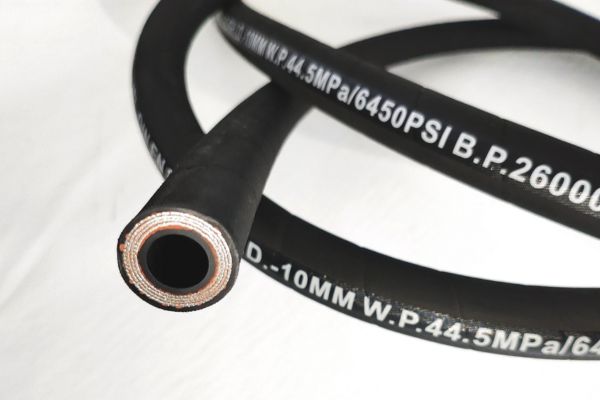
The Fitting Test
One of the simplest and most revealing checks is the fitting stem insertion test.
- Use a standard, correctly sized stem.
- Insert it by hand only, without tools or lubrication.
- The fit should be snug, smooth, and consistent — firm enough to resist free sliding, yet not so tight that it deforms the tube.
| Test Result | Interpretation |
| Stem slides in too easily | Bore too large → weak crimp and leakage risk |
| Stem cannot enter fully | Bore too small → risk of tearing inner tube |
| Smooth, uniform resistance | Correct dimensional tolerance |
A precise stem-to-bore match is the foundation of a reliable crimp seal. Any deviation here will show up later as leaks, blow-offs, or premature coupling fatigue.
Layer Adhesion — The True Test of Integrity
Inside every hydraulic hose are three essential layers:
- Inner tube — carries the fluid
- Reinforcement layer — provides strength
- Outer cover — protects from abrasion and weather
If these layers don’t bond tightly, the hose begins to separate internally — a process called delamination. This allows fluid to migrate between layers, forming blisters and eventually tearing the hose apart under pressure.
Simple adhesion check: Cut a short section of hose and attempt to peel the layers apart by hand.
- Quality hose: layers are firmly fused — separation is nearly impossible without tools.
- Inferior hose: layers separate easily, producing a sticky or powdery surface.
| Observation | Quality Assessment |
| Layers resist peeling | Strong adhesion and proper vulcanization |
| Layers separate with minimal effort | Poor bonding, likely delamination risk |
| Moisture or oil between layers | Internal migration and contamination |
Pro Tip: Good adhesion requires clean materials, precise curing temperature, and controlled bonding agents — all signs of disciplined manufacturing.
Under Pressure: Understanding Ratings and Testing
Ultimately, a hose’s quality is proven by its ability to perform under pressure. Understanding the standard pressure ratings—and the tests behind them—allows you to select a product that has been certified to handle the demands of your specific application safely.
Working Pressure: The Daily Limit
This is the maximum pressure a hose is designed to handle during normal, continuous operation. It is the single most important rating to consider when selecting a hose and should always be equal to or greater than your system’s maximum normal operating pressure.
Proof Pressure: The Factory Safety Check
Proof pressure testing is a quality control measure where every (or a statistical sample of) hose is pressurized to a level higher than its working pressure—typically twice the working pressure—and held for a short period. It is designed to expose any manufacturing defects without damaging the hose.
Burst Pressure: The Ultimate Limit
This is the pressure at which a hose will physically rupture. It is a key indicator of quality and design margin. Industry standards typically require a hose’s minimum burst pressure to be three to four times its maximum rated working pressure, providing a critical safety factor.
| SAE 100R2AT Hose Example | Working Pressure | Min. Proof Pressure | Min. Burst Pressure |
| 1/4″ (-4) I.D. | 5,800 PSI | 11,600 PSI | 23,200 PSI |
| 3/8″ (-6) I.D. | 4,790 PSI | 9,570 PSI | 19,140 PSI |
| 1/2″ (-8) I.D. | 4,000 PSI | 8,000 PSI | 16,000 PSI |
| 3/4″ (-12) I.D. | 2,250 PSI | 4,500 PSI | 9,000 PSI |
| 1″ (-16) I.D. | 1,825 PSI | 3,650 PSI | 7,300 PSI |
Note: Values are for example only. Always refer to the specific manufacturer’s catalog for certified pressure ratings.
Red Flags: Common Defects of Inferior Hydraulic Hoses
Every failed hydraulic hose tells a story — usually about poor materials, weak reinforcement, or inadequate bonding. Recognizing these warning signs early can prevent system failure, equipment damage, and safety risks.
Excessive Change in Length
When pressurized, all hoses expand or contract slightly — this is normal. But excessive length change is a red flag for poor reinforcement design or improper braiding tension.
| Symptom | Possible Cause | Effect |
| Hose elongates noticeably under pressure | Weak wire braid or loose spiral winding | Puts stress on fittings and clamps |
| Hose contracts excessively | Incorrect reinforcement angle | Can cause hose routing misalignment |
| Repeated flexing causes fitting loosening | Fatigue from excessive movement | Leads to leaks and premature failure |
What to do:
- Avoid cheap, low-tensile reinforcement wire.
- Always specify hoses that meet SAE or EN standards for length change tolerance (typically ±2–4% at working pressure).
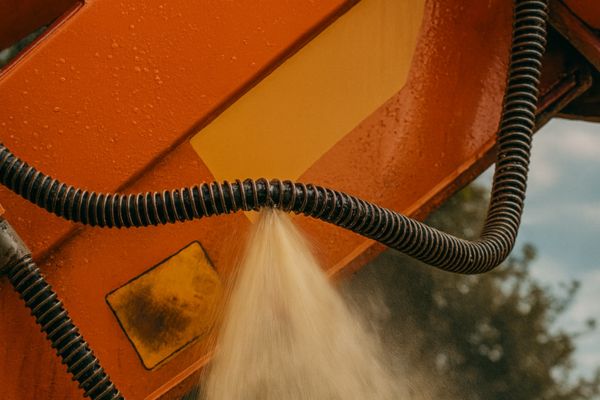
Permeability and Cover Blisters
A hose’s outer cover and inner tube must be airtight. When permeability is poor, the result is moisture ingress or trapped gas — both of which destroy the reinforcement from within.
Two common failure paths:
- External attack: Environmental humidity seeps through a porous outer cover, corroding the steel reinforcement wire.
- Internal gas migration: Dissolved gas in the hydraulic fluid travels outward, forming bubbles or blisters under the cover.
| Observation | Likely Root Cause | Preventive Action |
| Small raised blisters along the cover | Gas diffusion through inner tube | Use low-permeability inner tubes (e.g., NBR or CR blends) |
| Rust-colored spots under the cover | Moisture penetration | Select covers with higher ozone and oil resistance |
| Cover cracking near fittings | Trapped gas pressure release | Inspect for internal degradation or improper storage |
Tip: If blisters appear soon after installation, the problem may not be chemical — it’s likely permeability-related manufacturing flaws.
Delamination and Internal Failure
Delamination is among the most catastrophic hose failures — and almost always points to poor manufacturing quality. It happens when the layers (inner tube, reinforcement, and cover) lose adhesion.
Typical indicators:
- Visible “peeling” or separation between layers
- Bulging near the crimp or mid-section
- Sudden burst without prior surface wear
When adhesion fails, pressurized fluid forces its way between layers, tearing them apart internally. This leads to explosive rupture and total system shutdown.
| Cause | Description |
| Incomplete vulcanization | Layers not bonded due to uneven curing |
| Contaminated bonding agent | Poor process control during assembly |
| Excessive heat or chemical exposure | Weakens layer adhesion over time |
Inspection Tip: Cut a failed hose lengthwise. If layers separate easily by hand, you’re looking at a delamination issue — a clear indicator of low-quality manufacturing.
FAQ
Is a more flexible hose always a better quality hose?
Not necessarily. While flexibility is important for routing, extremely high-pressure hoses (like 4- and 6-wire spiral hoses) are inherently stiffer due to their construction. Quality is about meeting the specified performance for its category, not just flexibility alone.
Can I judge a hose’s quality by its price?
While premium brands often cost more, price isn’t a perfect indicator. Some lesser-known manufacturers produce excellent hose. Using the physical inspection techniques in this guide is a far more reliable method than relying on price or brand name alone.
What does the “AT” mean in a hose designation like SAE 100R2AT?
The “AT” is an SAE designation that indicates the hose meets specific dimensions allowing it to be used with a wide range of standard, non-skive fittings. It essentially refers to the controlled outside diameter (O.D.) of the hose.
How important is the country of origin when buying a hydraulic hose?
High-quality hydraulic hose is produced by reputable manufacturers all over the world, including in North America, Europe, and Asia. It’s more important to assess the quality of the product itself and the reputation of the manufacturer than to focus solely on the country of origin.
My hose has the correct pressure rating but failed anyway. Is it a low-quality hose?
It’s possible, but it’s more likely that the failure was caused by the application. Factors like excessive pressure spikes (impulses), routing that violates the minimum bend radius, external abrasion, or extreme temperatures can destroy even the highest quality hose prematurely.
Does the cover color mean anything for the quality?
Generally, no. The standard color for a hose cover is black because carbon black is an excellent additive for UV and ozone resistance. Other colors are used for identification (e.g., marking pressure lines vs. return lines) but do not inherently signify a higher or lower quality.



